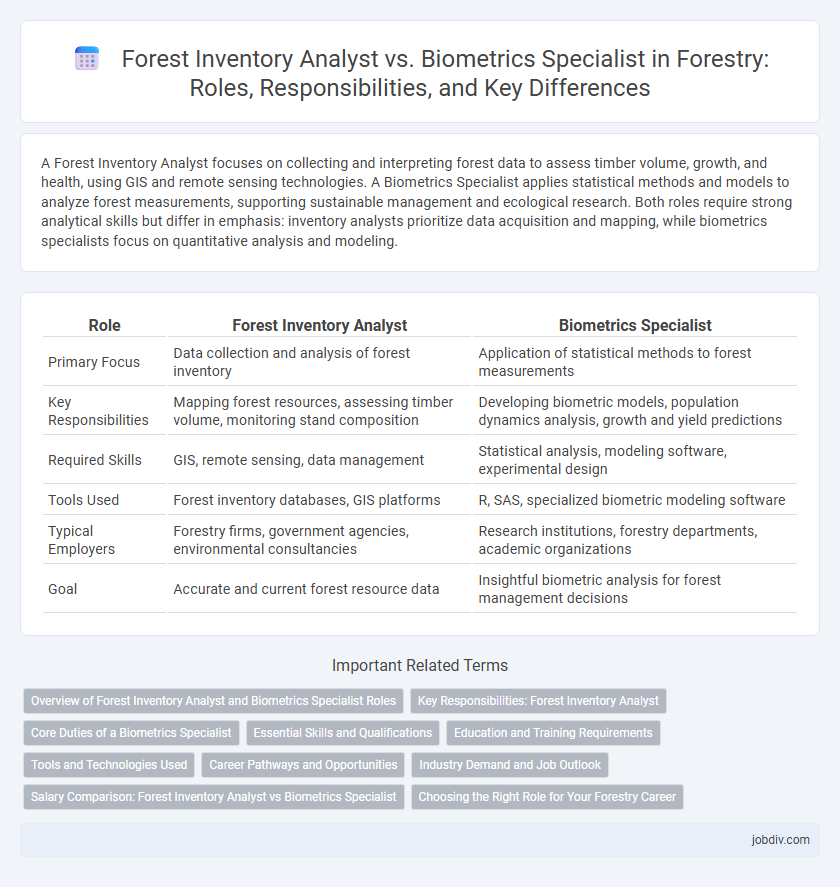A Forest Inventory Analyst focuses on collecting and interpreting forest data to assess timber volume, growth, and health, using GIS and remote sensing technologies. A Biometrics Specialist applies statistical methods and models to analyze forest measurements, supporting sustainable management and ecological research. Both roles require strong analytical skills but differ in emphasis: inventory analysts prioritize data acquisition and mapping, while biometrics specialists focus on quantitative analysis and modeling.
Table of Comparison
| Role | Forest Inventory Analyst | Biometrics Specialist |
|---|---|---|
| Primary Focus | Data collection and analysis of forest inventory | Application of statistical methods to forest measurements |
| Key Responsibilities | Mapping forest resources, assessing timber volume, monitoring stand composition | Developing biometric models, population dynamics analysis, growth and yield predictions |
| Required Skills | GIS, remote sensing, data management | Statistical analysis, modeling software, experimental design |
| Tools Used | Forest inventory databases, GIS platforms | R, SAS, specialized biometric modeling software |
| Typical Employers | Forestry firms, government agencies, environmental consultancies | Research institutions, forestry departments, academic organizations |
| Goal | Accurate and current forest resource data | Insightful biometric analysis for forest management decisions |
Overview of Forest Inventory Analyst and Biometrics Specialist Roles
Forest Inventory Analysts specialize in collecting, analyzing, and managing data on forest composition, health, and growth to support sustainable management and conservation efforts. Biometrics Specialists focus on applying statistical models and quantitative methods to interpret forestry data, improving accuracy in measuring forest attributes such as volume, biomass, and carbon stocks. Both roles require expertise in data analysis and forest ecology but differ in emphasis, with Analysts concentrating on field data collection and management, while Specialists prioritize advanced statistical evaluation.
Key Responsibilities: Forest Inventory Analyst
Forest Inventory Analysts specialize in collecting, analyzing, and managing data related to forest resources, employing remote sensing technology and geographic information systems (GIS) to assess tree density, species distribution, and forest health. They produce detailed reports and maps that support sustainable forest management, timber harvest planning, and environmental impact assessments. Proficiency in statistical software and data modeling enables them to generate accurate forest stand estimations and growth projections.
Core Duties of a Biometrics Specialist
A Biometrics Specialist in forestry primarily focuses on collecting, analyzing, and interpreting quantitative data related to forest growth, health, and yield. They utilize statistical models and software tools to assess timber volumes, forest stand dynamics, and environmental impacts. Their core duties include field data measurement, database management, and developing predictive growth models for sustainable forest management.
Essential Skills and Qualifications
A Forest Inventory Analyst requires proficiency in geographic information systems (GIS), remote sensing, and statistical analysis to accurately assess forest resources. Biometrics Specialists specialize in applying advanced quantitative methods and ecological modeling to monitor forest growth, health, and biodiversity. Both roles demand strong data interpretation skills, experience with forest management software, and a background in forestry or environmental science.
Education and Training Requirements
A Forest Inventory Analyst typically holds a bachelor's degree in forestry, natural resources, or environmental science, emphasizing skills in data collection, GIS, and statistical analysis. Biometrics Specialists generally require advanced education, often a master's or doctoral degree in forestry, biometrics, or applied statistics, with extensive training in population modeling, growth and yield prediction, and forest measurement techniques. Both roles demand proficiency in forest inventory methods, but Biometrics Specialists focus more on complex quantitative analysis and biostatistical modeling.
Tools and Technologies Used
Forest Inventory Analysts utilize geographic information systems (GIS), remote sensing technologies, and data management software to collect and analyze forest resource data, enabling accurate mapping and inventory assessments. Biometrics Specialists employ statistical software such as R or SAS, advanced modeling tools, and specialized measurement instruments to analyze growth trends, genetic variation, and population dynamics within forest ecosystems. Both roles integrate drone technology and LiDAR scanning to enhance data precision and support sustainable forest management decisions.
Career Pathways and Opportunities
A Forest Inventory Analyst primarily focuses on collecting and analyzing forest data to support sustainable management decisions, often working with GIS and remote sensing technologies. Biometrics Specialists apply statistical methods and models to interpret forestry data, guiding growth projections and yield estimates critical for forest resource planning. Career pathways for Forest Inventory Analysts often lead to roles in environmental consulting and forest management, while Biometrics Specialists typically advance into research, policy development, and advanced quantitative analysis positions within forestry organizations.
Industry Demand and Job Outlook
The Forestry sector shows strong demand for Forest Inventory Analysts due to increasing needs for precise data on forest resources to support sustainable management and policy decisions. Biometrics Specialists are equally sought after, leveraging advanced statistical analysis and modeling to enhance forest growth projections and yield predictions. Both roles are projected to grow steadily, driven by expanding environmental regulations and the growing emphasis on climate change mitigation strategies in forest management.
Salary Comparison: Forest Inventory Analyst vs Biometrics Specialist
Forest Inventory Analysts typically earn a median salary ranging from $55,000 to $70,000 annually, depending on geographic location and experience, while Biometrics Specialists generally command higher salaries averaging between $65,000 and $85,000 due to their advanced statistical expertise and specialized skill set. Industry demand for Biometrics Specialists in forestry research and ecosystem modeling contributes to their competitive compensation packages compared to Forest Inventory Analysts focused on data collection and stand assessment. Salary variations also reflect differences in educational requirements, with Biometrics Specialists often holding advanced degrees that enhance earning potential within forestry science.
Choosing the Right Role for Your Forestry Career
Forest Inventory Analysts focus on collecting and analyzing data to assess forest resources, optimizing timber yield and sustainability. Biometrics Specialists apply advanced statistical models to interpret forest growth, health, and regeneration metrics, supporting informed management decisions. Choosing the right role depends on whether you prefer field data collection and resource assessment or specialized data modeling and quantitative analysis.
Forest Inventory Analyst vs Biometrics Specialist Infographic

 jobdiv.com
jobdiv.com